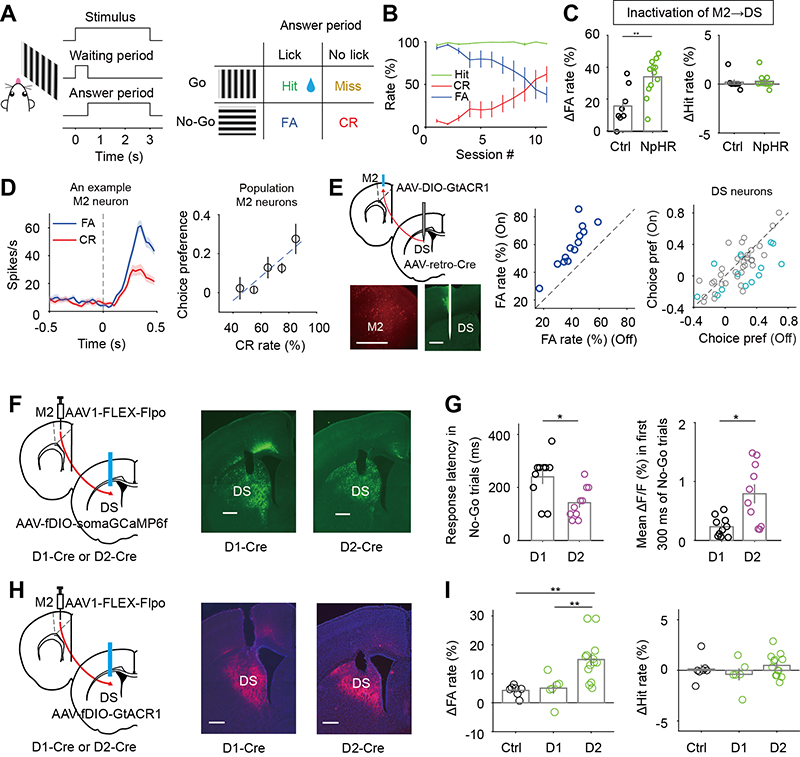Time:2023-06-01
A recent study published in Neuroscience Bulletin reveals that the secondary motor cortex to dorsal striatum pathway is crucial for suppressing inappropriate responses in visual perceptual decision behavior. This work was performed by researchers in Dr. YAO Haishan’s Lab at the Institute of Neuroscience, Center for Excellence in Brain Science and Intelligence Technology of the Chinese Academy of Sciences, State Key Laboratory of Neuroscience.
Perceptual decision processes involve distributed neural circuits in the brain, particularly sensorimotor cortical regions and basal ganglia. A key region of sensorimotor transformation in rodents is the secondary motor cortex (M2), which is a homolog of the primate premotor cortex, supplementary motor area, or frontal eye field. M2 neurons innervate the dorsal striatum (DS), which contributes to decision-making behavior. It remains unclear, however, how M2 inputs influence decision-related activity in the striatum, and how direct or indirect pathway striatal neurons defined by M2 inputs support perceptual decision behavior.
The authors examined the functional role of M2-DS pathway using a visual Go/No-Go task in mice. They found that the DS-projecting M2 neurons and the projections from M2 to DS played a causal role in suppressing inappropriate licking for the reward-irrelevant No-Go stimulus. Both M2 and DS neurons exhibited choice-related signals in response to the No-Go stimulus, and inactivation of the DS-projecting M2 neurons reduced choice signal in the DS. Compared to the direct pathway striatal neurons, the indirect pathway striatal neurons defined by M2 inputs showed earlier response to the No-Go stimulus. Furthermore, inhibiting the indirect pathway striatal neurons defined by M2 inputs during the early waiting period led to a larger increase in FA rate than inactivation of the direct pathway striatal neurons. In summary, Dr. Yao’s lab demonstrates that specific cell types in the M2-DS circuit are essential for withholding response to reward-irrelevant sensory stimulus.
This work entitled “The Secondary Motor Cortex-Striatum Circuit Contributes to Suppressing Inappropriate Response in Perceptual Decision Behavior” was published online in Neuroscience Bulletin on May 31, 2023. This work was completed by LIU Jing, under the supervision of Dr. YAO Haishan, with help from Dr. LIU Dechen, PU Xiaotian, ZOU Kexin, Dr. XIE Taorong, and LI Yaping. This work was supported by grants from Ministry of Science and Technology, National Natural Science Foundation of China, Chinese Academy of Sciences, and Shanghai Municipal Government.

Regulation of visual perceptual decision behavior by the M2-DS circuit
Figure legend: A Schematic of the task structure. B Performance of the mice across training sessions. C Inactivation of M2 axon terminals in the DS increases the FA rate. D The choice preference of M2 neurons is positively correlated with behavioral performance. E Inactivation of the DS-projecting M2 neurons reduces the choice preference of DS neurons. F Schematic of the strategy for measuring the responses of direct or indirect pathway striatal neurons defined by M2 inputs. G Response latency in No-Go trials and the mean response within the first 300 ms of the No-Go trials. H Schematic of the strategy for inactivating the responses of direct or indirect pathway striatal neurons defined by M2 inputs. I Comparison of the change in FA rate or Hit rate among the three groups of mice in experiments in which laser stimulation was applied during the first 300 ms of visual stimulus.
Keywords: Secondary Motor Cortex-Striatum Circuit ;Visual Perceptual Decision Behavior
AUTHOR CONTACT
YAO Haishan, Ph.D.
Center for Excellence in Brain Science and Intelligence Technology, Chinese Academy of Sciences, Shanghai, China.
Email:haishanyao@ion.ac.cn
 附件下载:
附件下载: